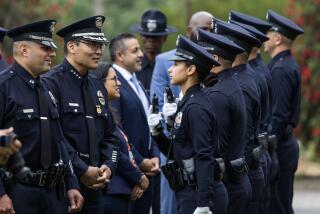Crime in Cities Outruns Police Manpower, Study Finds
- Share via
WASHINGTON — Rates of violent crime in the nation’s 59 largest cities rose 43% from 1977 through 1987, but the police departments of those cities grew by only 2% in that period, according to a Justice Department report released Sunday.
The study, conducted by Brian A. Reeves of the department’s Bureau of Justice Statistics, found that cities of 250,000 or more people employed 120,000 regular police officers in 1987. After allowing for changes in population and areas served, the report said, the average city had 2.3 full-time, sworn officers for each 1,000 residents--a shade fewer than the 2.4-officers-per-1,000 ratio of 10 years earlier.
“This lack of increase in the number of sworn officers relative to population and land areas contrasts with changes in the volume of serious crimes reported to these police departments over the same period,” the report said.
Crime Ratio Up
Nationwide during the 10 years studied, the number of violent crimes on the Justice Department’s Uniform Crime Reports index rose to an average of 10,012 per 100,000 residents from 8,195 per 100,000, an average increase of 22%, the report said. The violent crime index compiles nationwide data on incidents of murder, negligent manslaughter, rape, robbery and aggravated assault.
Although their numbers are relatively stable, the report said, regular police departments in several cities work in cooperation with special units of other jurisdictions. Among these is the Los Angeles Police Department, the nation’s third-largest force, which had 7,032 regular officers in 1987 while the Los Angeles County Sheriff’s Department had a further 6,508 officers on its roster.
The nation’s largest police department, New York City’s force of 27,478, was backed up by five specialized departments with 10,100 other officers, the report said. The special departments are those with law enforcement jurisdiction over the city’s transit system, public schools, public housing, transportation hubs and fire investigations.
More ‘Civilian’ Employees
The report noted a trend toward “civilianization” of police work not directly involved with law enforcement. It said that the proportion of non-uniformed employment has increased to 23% from 20.5%, with non-uniformed personnel taking over assignments such as research and training, forensic analyses and equipment maintenance, as well as routine clerical and communications chores.
The survey, the Justice Department’s first overall study of big-city police departments, will make it possible to measure “how law enforcement agencies are meeting their challenges” when a follow-up study is undertaken next year, Joseph M. Bessette, acting director of the statistical bureau, said in a foreword to the report.
The report, based entirely on data for 1987 and the earlier years, makes these points:
--While the largest cities generally had the highest ratio of police to population, Washington, with 622,000 inhabitants and a police force of 3,878--and a current reputation as the nation’s murder capital--was at the top of this category with 6.2 officers per 1,000 residents.
Big City Ratios
The ratios for the biggest cities: New York, 7.2 million inhabitants and 3.8 officers per 1,000 population; Chicago, 3 million people and a 4.1 ratio; Los Angeles (city), 3.3 million and a 2.1 ratio; Philadelphia, 1.6 million inhabitants and a 4.1 ratio; Detroit, 1.1 million population and a 4.7 ratio. The lowest ratio, 1.5 police per 1,000, was found in both San Diego, with 1 million inhabitants, and San Antonio, population 920,000.
--More than 93% of patrolling hours on the average big-city force were allocated to vehicular units, but cities of 1 million or more people assigned an average of 10% of police time to foot patrols.
--Cities of more than 1 million population kept an average of 27.1 cars for every 100 officers; cities of less than 500,000 people averaged 46 cars for each 100 police.
Automation of Records
--Use of computers to log arrests, service calls and property thefts was widespread among police departments and universal in those responsible for 500,000 or more people. Police training required more than 1,000 hours of classroom and field work in departments of all sizes, and cost an average of $15,000 per recruit.
--Detroit had the highest proportion of women to men on the police force (16.9%). The District of Columbia reported the highest proportion of blacks (54.8%), and San Antonio employed the largest proportion of Latinos (38.2%). In Los Angeles, the figures were 8.8% women, 11.7% blacks and 16.1% Latinos. The San Diego force was 12.2% female, 6.6% black and 10.2% Latino; San Francisco reported 10.2% women, 8.5% blacks and 9.9% Latinos.
More to Read
Sign up for Essential California
The most important California stories and recommendations in your inbox every morning.
You may occasionally receive promotional content from the Los Angeles Times.










